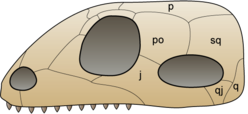
The squamosal is a skull bone found in most reptiles, amphibians, and birds. In fishes, it is also called the pterotic bone.[1]
In most tetrapods, the squamosal and quadratojugal bones form the cheek series of the skull.[2] The bone forms an ancestral component of the dermal roof and is typically thin compared to other skull bones.[3]
The squamosal bone lies ventral to the temporal series and otic notch, and is bordered anteriorly by the postorbital. Posteriorly, the squamosal articulates with the quadrate and pterygoid bones. The squamosal is bordered anteroventrally by the jugal and ventrally by the quadratojugal.[4]
Function in reptiles[edit]
In reptiles, the quadrate and articular bones of the skull articulate to form the jaw joint. The squamosal bone lies anterior to the quadrate bone.[3]
Anatomy in synapsids[edit]
Non-mammalian synapsids[edit]
In non-mammalian synapsids, the jaw is composed of four bony elements and referred to as a quadro-articular jaw because the joint is between the articular and quadrate bones. In therapsids (advanced synapsids including mammal), the jaw is simplified into an articulation between the dentary and the squamous part of the temporal bone, and hence referred to as a dentary-squamosal jaw.
Mammals[edit]
In many mammals, including humans, the squamosal fuses with the periotic bone and the auditory bulla to form the temporal bone, then referred to as the squama temporalis.
In mammals, the quadrate bone evolves to form the incus, one of the ossicles of the mammalian ear.[5] Similarly, the articular bone evolves to form the malleus. The squamosal bone migrates and lengthens to become a new point of articulation with the lower jaw (at the dentary bone).[3]
References[edit]
- ^ Allis, Edward Phelps (1919). "On the homologies of the squamosal bone of fishes". The Anatomical Record. 17 (2): 72–87. doi:10.1002/ar.1090170202. S2CID 85000711.
- ^ Romer, Alfred Sherwood, 1894-1973. (1978). The vertebrate body : shorter version. Parsons, Thomas S. (Thomas Sturges), 1930- (5th ed.). Philadelphia: Saunders. ISBN 0-7216-7682-0. OCLC 3345587.
{{cite book}}: CS1 maint: multiple names: authors list (link) CS1 maint: numeric names: authors list (link) - ^ a b c Homberger, Dominique G. (2004). Vertebrate dissection. Walker, Warren F. (Warren Franklin), Walker, Warren F. (Warren Franklin). (9th ed.). Belmont, CA: Thomson Brooks/Cole. ISBN 0-03-022522-1. OCLC 53074665.
- ^ Roemer, A. S. (1956). Osteology of the Reptiles. University of Chicago Press. p. 772.
- ^ Carr, Steven M. (2005). "Quadroarticular vs Dentary-Squamosal jaw". Memorial University of Newfoundland. Retrieved 2018-04-09.
Well, that’s interesting to know that Psilotum nudum are known as whisk ferns. Psilotum nudum is the commoner species of the two. While the P. flaccidum is a rare species and is found in the tropical islands. Both the species are usually epiphytic in habit and grow upon tree ferns. These species may also be terrestrial and grow in humus or in the crevices of the rocks.
View the detailed Guide of Psilotum nudum: Detailed Study Of Psilotum Nudum (Whisk Fern), Classification, Anatomy, Reproduction